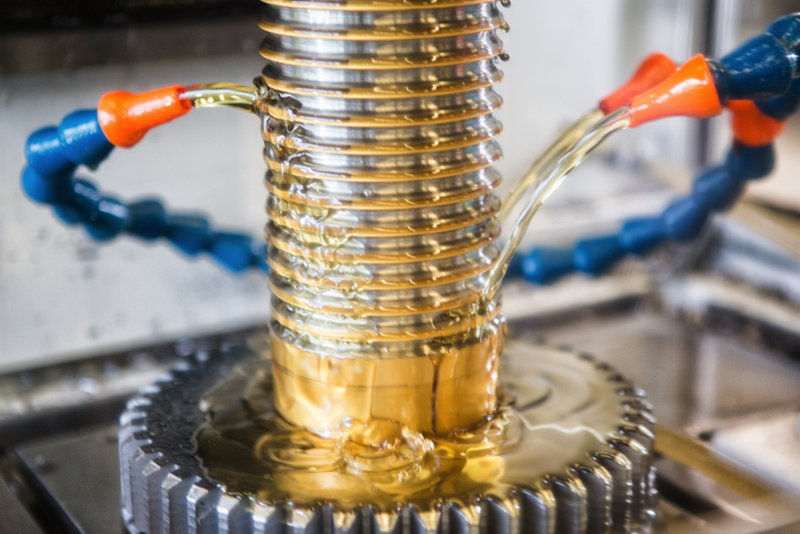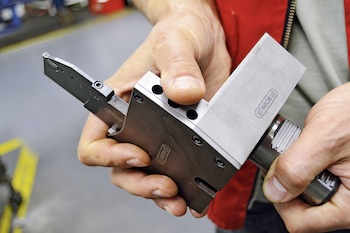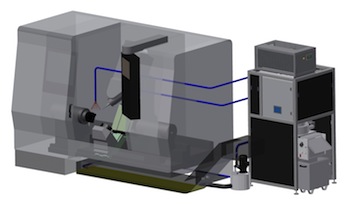The latest coolant and cutting-oil technologies can support automotive's drive for ever higher productivity
To meet demanding output schedules, automotive manufacturing engineers have little option but to machine fast. However, if there is one thing certain to cause heat in machining operations, it is fast cutting speeds and high feed rates. With this in mind, the correct selection and application of coolant is vital in the quest for ever greater productivity – without compromising quality – particularly when the workpiece is made from challenging materials.
Take valve seats, for example. Today, both intake and exhaust valve seats are fabricated from highly alloyed, ferrous powdered metals in order to obtain higher strength, wear resistance and heat transfer properties. While such properties are beneficial for maintaining optimum valve-seat condition over long periods of operation, the machining of these hard materials presents significant challenges which require proper selection of cutting speeds and feeds, cutting-tool material and edge preparation, as well as the use of effective metalworking fluids.
“While machining conditions are selected to provide optimum surface quality, the metalworking fluid used provides the lubrication and cooling necessary for minimising cutting insert wear and maximising insert life,” says Robert Evans, research scientist at Quaker Chemical Corporation, who has performed extensive research into valve-seat machining. “With an understanding that the metalworking fluid is a critical component of valve-seat machining performance, it’s useful to further consider the following elements of the process: the mechanism of insert wear; the relationship of wear to machined surface quality; and the role of metalworking fluid in cutting insert wear.”

In respect of the mechanism of insert wear, with proper selection of cutting conditions and cutting-edge preparation, hard cutting materials like cubic boron nitride will perform effectively without any catastrophic wear failure, such as galling or fracture. However, with continued use, steady mechanical abrasive wear occurs on the flank face of the cutting inserts. “Studies have shown that this wear increases linearly with continued machining, the rate of which is influenced by cutting conditions, and the quality of the metalworking fluid used,” says Evans.
Regarding the relationship of wear to machined surface quality, during machining, flank wear length can be measured and used to define an insert failure criterion – the point at which the surface quality of the valve seat begins to degrade and the insert can no longer be used.
During initial use of a cutting insert, insert wear produces minimal change in the quality of the machined valve-seat surface. However, as wear progresses and the failure criterion is reached, a clear transition in machined surface quality occurs. “Surface roughness remains fairly constant up to the failure criterion of the insert, at which point a rapid increase in surface roughness occurs,” says Evans. “What’s more, optical interferometric images reveal a smooth, uniform surface contour obtained prior to insert failure, and a non-uniform surface profile following insert failure.”
So, what of the role of metalworking fluids in cutting insert wear? Quaker Chemical says the quality of the fluid is a significant factor impacting the rate of insert wear in valve-seat machining. Studies suggest that lower-performing fluids will result in a higher rate of insert wear. “The benefit realised from the use of higher-performing fluids is significant, and can represent between a 30% to 50% increase in cutting insert life,” says Evans.
Multi-tasking coolants
Another area that can benefit enormously from advanced cutting-fluid technology is the machining of transmission gear teeth using grinding techniques. “Trends in engine downsizing and noise-optimised engines require even more precisely ground gear teeth with tight tolerances,” says Meinhard Kiehl, director of marketing and product management at Rhenus Lub. “Just as important, however, is that production is as economic as possible.”

When selecting the fluid, flushing properties, foaming behaviour and flashpoint are technical and safety-related properties that narrow the range of suitable products. In practice, well-known gear manufacturers rely on low-emission, low-viscosity neat oils, which are proven to better remove process heat. In addition, coolants with a lower viscosity exhibit superior flushing properties, increase the sedimentation rate of the metal chips or abrasion, and are characterised by a high filtering capability and good air separation.
Of course, selecting the right fluid is only half the battle. In fact, coolant performance is impaired significantly unless it is delivered accurately into the cutting zone, as testified by Febi Bilstein of Ennepetal, Germany. This supplier of replacement automotive parts to OEM standards, has seen tool life quadruple with the adoption of Horn S100 groove/part-off inserts featuring internal cooling capability.
Precision cooling for longer life
Febi Bilstein makes car and commercial vehicle replacement parts, such as chain tensioners, axle bolts, wheel hubs and wishbones, in annual quantities of up to 200,000. Many shafts are produced on a Gildemeister CTX 1250 TC4A from DMG Mori by means of parallel machining on the main and counter spindle, as well as a full milling spindle. Typical shaft material is tempered 42CrMoS4 with strengths of 980-1,200N/sq.mm, which is tough and not easy to machine. However, the combination of insert with internal cooling and VDI-40 holder has paid huge dividends.
The VDI-40 holder uses the standard KSS port of the revolver and in this case, with 25 bar pressure coolant, in a continuous KSS channel feeding coolant up to the nozzle of the insert. The coolant jet impinges directly on the cutting edge to improve machining conditions. Here, the specially designed nozzle shape of the KSS channel ensures a coolant jet directed towards the precise active point, which supports chip removal and reduces the risk of swarf congestion. This simultaneously cools the insert and reduces the formation of built-up edges and premature cutting-edge wear.
“Internal cooling increased the service life of the inserts by a factor of four,” explains production manager Christian Erlenkötter, “and although the overall system with the new holder is slightly more expensive, tool costs have been halved. In addition, the quadrupled tool life reduces tool changes and thus increases the up-time of the machine.”
Machine setter Michael Krüsel confirms: “Even with long intervention periods and at high temperatures and internal cooling, the inserts ensure excellent chip flow and long tool life.”
The powertrain and engine facility of Opel Szentgotthárd in Hungary is a prime example of what auto plants can achieve by adopting the latest coolant management technologies. Until recently, the plant was still running central emulsion systems that were first installed in 1996 to supply the machining lines with coolants. The pumps ran continuously, with excess emulsion recirculated back to the central system via a bypass line. During the improvement project, on which Opel collaborated with Siemens Zrt and Dürr Ecoclean, the bypass line was dismantled and a self-teaching control system was implemented.
With the new approach, the plant was able to provide intelligent emulsion supply by taking into account a significant number of operation parameters. For instance, incorporated measurement devices follow the variation of the emulsion pressure in the different systems, while an algorithm adjusts the necessary level of intervention. The system is now able to maintain energy-efficient working processes using the adaptive power control of the emulsion supply pumps.
As a result of the project, one of the existing central coolant system pumps at Opel could be disabled, allowing power demand to decrease by 270kWh. This allowed the plant to achieve a reduction in electricity consumption of 1,760MWh a year, equal to a cost saving of €184,000 ($202,000), which in turn corresponds to an annual 595-tonne reduction in CO2 emissions.
Zebra Skimmers has recently launched a system capable of managing as many as ten machine sumps automatically from a single drum of chemical concentrate. The company says its Dazzle Archi is the only such computerised system capable of managing coolant concentration levels for multiple machines. The units maintain concentration levels to within 0.5% and can determine the evaporation rate of each sump.
























